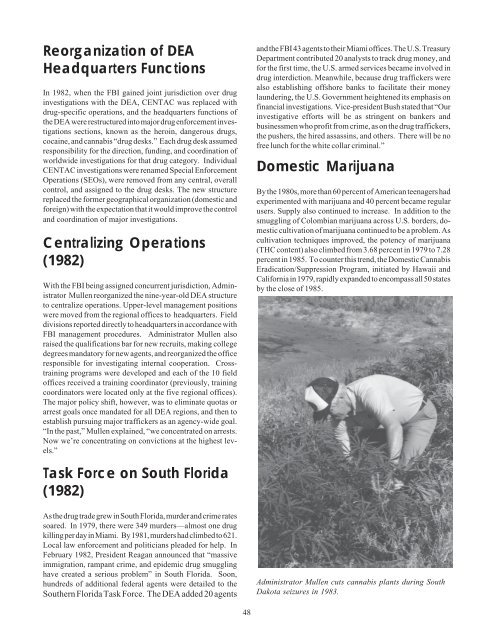Download This File - The Free Information Society
Download This File - The Free Information Society
Download This File - The Free Information Society
Create successful ePaper yourself
Turn your PDF publications into a flip-book with our unique Google optimized e-Paper software.
Reorganization of DEA<br />
Headquarters Functions<br />
In 1982, when the FBI gained joint jurisdiction over drug<br />
investigations with the DEA, CENTAC was replaced with<br />
drug-specific operations, and the headquarters functions of<br />
the DEA were restructured into major drug enforcement investigations<br />
sections, known as the heroin, dangerous drugs,<br />
cocaine, and cannabis “drug desks.” Each drug desk assumed<br />
responsibility for the direction, funding, and coordination of<br />
worldwide investigations for that drug category. Individual<br />
CENTAC investigations were renamed Special Enforcement<br />
Operations (SEOs), were removed from any central, overall<br />
control, and assigned to the drug desks. <strong>The</strong> new structure<br />
replaced the former geographical organization (domestic and<br />
foreign) with the expectation that it would improve the control<br />
and coordination of major investigations.<br />
Centralizing Operations<br />
(1982)<br />
With the FBI being assigned concurrent jurisdiction, Administrator<br />
Mullen reorganized the nine-year-old DEA structure<br />
to centralize operations. Upper-level management positions<br />
were moved from the regional offices to headquarters. Field<br />
divisions reported directly to headquarters in accordance with<br />
FBI management procedures. Administrator Mullen also<br />
raised the qualifications bar for new recruits, making college<br />
degrees mandatory for new agents, and reorganized the office<br />
responsible for investigating internal cooperation. Crosstraining<br />
programs were developed and each of the 10 field<br />
offices received a training coordinator (previously, training<br />
coordinators were located only at the five regional offices).<br />
<strong>The</strong> major policy shift, however, was to eliminate quotas or<br />
arrest goals once mandated for all DEA regions, and then to<br />
establish pursuing major traffickers as an agency-wide goal.<br />
“In the past,” Mullen explained, “we concentrated on arrests.<br />
Now we’re concentrating on convictions at the highest levels.”<br />
Task Force on South Florida<br />
(1982)<br />
As the drug trade grew in South Florida, murder and crime rates<br />
soared. In 1979, there were 349 murders—almost one drug<br />
killing per day in Miami. By 1981, murders had climbed to 621.<br />
Local law enforcement and politicians pleaded for help. In<br />
February 1982, President Reagan announced that “massive<br />
immigration, rampant crime, and epidemic drug smuggling<br />
have created a serious problem” in South Florida. Soon,<br />
hundreds of additional federal agents were detailed to the<br />
Southern Florida Task Force. <strong>The</strong> DEA added 20 agents<br />
48<br />
and the FBI 43 agents to their Miami offices. <strong>The</strong> U.S. Treasury<br />
Department contributed 20 analysts to track drug money, and<br />
for the first time, the U.S. armed services became involved in<br />
drug interdiction. Meanwhile, because drug traffickers were<br />
also establishing offshore banks to facilitate their money<br />
laundering, the U.S. Government heightened its emphasis on<br />
financial investigations. Vice-president Bush stated that “Our<br />
investigative efforts will be as stringent on bankers and<br />
businessmen who profit from crime, as on the drug traffickers,<br />
the pushers, the hired assassins, and others. <strong>The</strong>re will be no<br />
free lunch for the white collar criminal.”<br />
Domestic Marijuana<br />
By the 1980s, more than 60 percent of American teenagers had<br />
experimented with marijuana and 40 percent became regular<br />
users. Supply also continued to increase. In addition to the<br />
smuggling of Colombian marijuana across U.S. borders, domestic<br />
cultivation of marijuana continued to be a problem. As<br />
cultivation techniques improved, the potency of marijuana<br />
(THC content) also climbed from 3.68 percent in 1979 to 7.28<br />
percent in 1985. To counter this trend, the Domestic Cannabis<br />
Eradication/Suppression Program, initiated by Hawaii and<br />
California in 1979, rapidly expanded to encompass all 50 states<br />
by the close of 1985.<br />
Administrator Mullen cuts cannabis plants during South<br />
Dakota seizures in 1983.

















